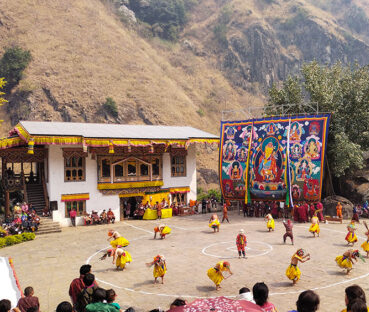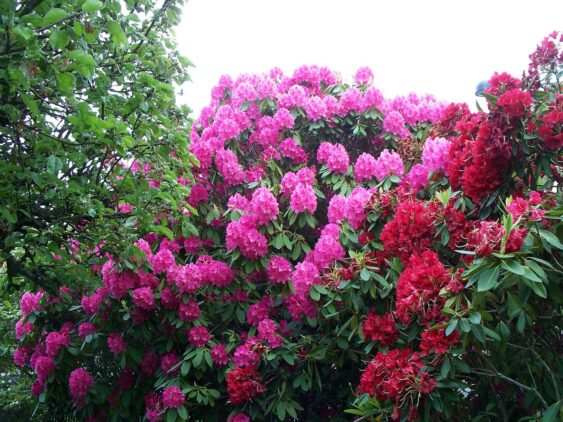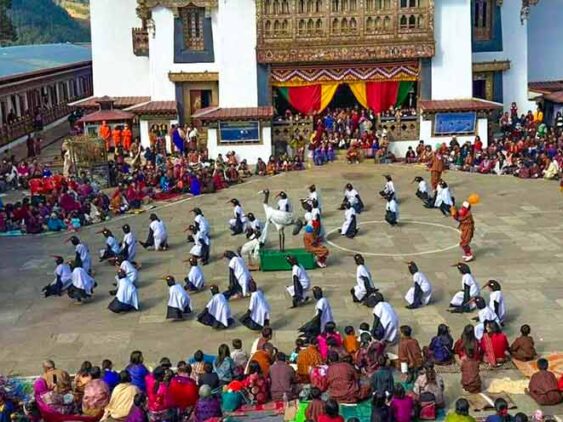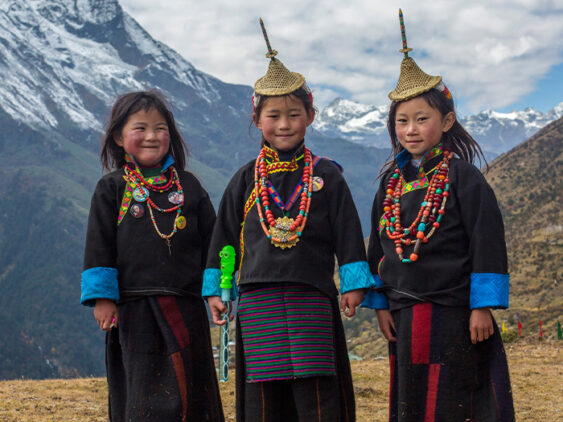
Gomphu Kora Festival
Destination: 8 Nights / 9 Days
Destination Covered : Paro, Thimphu, Wangdue, Trongsa, Bumthang, Mongar, Trashigang and Trashiyangtse
Tour Activities : Witness Festival, Museums, Sightseeing, etc.
Tour Themes : Hill Stations & Valleys, Religious & Pilgrimage, Culture & Heritage
Fill Enquiry Form Below
Bhutan Culture Overview
An invitation to explore the intricacy of Bhutanese culture and heritage that is sure to leave an indelible mark on your heart.
Traditional Architecture
On the mountain tops, cliff faces and in the valleys of Bhutan, you will find ornately designed and crafted dzongs or fortresses, monasteries, and traditional houses. Adorned with colorful paintings and attention-demanding carvings, these architectural marvels are a peek into Bhutan’s unique craftsmanship.
These ancient fortresses are religious and administrative centers, holding significance in the Bhutanese culture with some housing sacred relics while others serve as hubs for community gatherings and religious activities.
Culture and Etiquette
The essence of Bhutanese culture stands on its respect for elders, reverence for nature, and a strong sense of community.
A established sense of belongingness and togetherness is seen in the community where respect is expressed by addition of “la” at the end of a sentence when talking to someone else irrespective of their age. Where a younger might address some older as "Aue," meaning elder sibling irrespective of their known relation.
Other manners of etiquette can be noted in every Bhutanese in everyday life. Embracing these cultural norms lets you get a feel of what it truly means to be a part of Bhutan.
Traditional Attire
Fabled to have the largest pocket in the world, the national dress of Bhutan known as Gho (for men) and Kira (for women) is an integral part of being a Bhutanese. These garments are a vibrant symbol of Bhutanese culture and tradition and are worn on all occasions, festivals, and even everyday life.
The gho is a knee-length robe adorned with intricate patterns, paired with knee-high socks and leather boots while the kira is an ankle-length dress wrapped elegantly around the body and often held together by a handwoven, traditional belt and complemented by a blouse and a colorful sash or rachu.
The Bhutanese attire showcases vibrant colors and patterns elaborately woven, passionately reflecting Bhutan’s diverse traditions and skilled craftsmanship. During the festivals and ceremonies, captivating jewelry embellishes the attire. The national dress of Bhutan is a timeless piece of elegance that captivates the soul.
Cuisine and Hospitality
A mix of everything Himalayan, the cuisine of Bhutan reflects the improvisation and adaption the Bhutanese made, giving birth to the rich palatal diversity.
You can savor spicy hot dishes like ema datsi (chili and cheese stew), snack on soft and plump momos (dumplings), or calm your nerves with suja (butter tea), while admiring the majestic landscapes of Bhutan and finding comfort in the warmth and hospitality of Bhutanese families and guesthouses.
Share a meal, a laugh or two, and endless memories.
Creativity
Despite its small size, Bhutan fosters a wide range of creativity. From traditional arts and crafts to modern arts and sculpting. From traditional masked dances to modern street dancers, we house it all.
More often than not, you can find yourself amidst a mix of traditional and modern art forms in the heart of Bhutan’s capital, Thimphu.
If you want a quiet time, you can take a stroll in one of the multiple art galleries and museums. You can meet the local artists at VAST (voluntary art studio Thimphu) and even share a drink or two.
If your dancing shoes are clacking, drop by the GOKAB studio and get grooving with Bhutanese dancers.
If you ever need a creative break, come to Bhutan.
Bhutan Culture Tour Itinerary
Day 1: Arrival in Paro
- Arrive at Paro International Airport.
- Our guide and driver will receive from airport to Thimphu.
- Visit Buddha Dordenma Statue. It is largest Buddha Statue in the world with 177 feet (54 m) and contains 100,000 8-inch-tall and 25,000 12-inch-tall gilded bronze Buddhas.
- Visit Motithang Takin Preserve: The takin is believed that the head of the goat is fixed it to the skeleton of the cow by the Divine Madman great Lam Drukpa Kuenlay. It is National Animal of Bhutan.
- Visit The Memorial Chorten. It was built in 1974 to honor the Third Druk Gyalpo Jigme Dorji Wangchuk (1928-1972) and it is a prominent landmark in capital city of Bhutan.
Day 2: Thimphu to Bumthang
- Enroute Dochula pass: This pass is located at an elevation of 3,100 metres (10,200 ft). There are 108 memorial chortens or stupas known as “Druk Wangyal Chortens”.
- Visit Kurjey Monastery: Kurjey Monastery stands magnificently in Chokor Valley of Bumthang. It was built by Minjur Tempa in 1652.
- Visit Jambay Monastery: Jambay Monastery is said to be one of the 108 temples built by King Songtsen Gampo in 659 CE on a single day, to pin down an ogress to earth forever.
- Visit Tamzhing Monastery: Tamzhing monastery was built in 1501 and is a principle seat of Pema Lingpa. This temple is well known for most unique mural paintings.
- Visit Kenchosum Monastery: The name Kenchosum monastery originated from three statues of Due_Sum Sangay, which were believed to have flown from Kusumphel in Kurtoe. Guru Rinpoche himself is said to have designed and consecrated the Kenchosum monastery, which is also known as Tsilung monastery.
Day 3: Bumthang to Trashigang
- Thrumshingla Pass also called as Donga Pass is the second-highest mountain pass in Bhutan, connecting its central and eastern regions.
Day 4: Trashigang to Gomphu Kora (Gomphu Koro is 40 Minutes’ drive from Trashigang)
- Visit Gomphu Kora: Gomphu meaning ‘a sacred meditation site of Guru Rinpoche’ and Kora meaning ‘Circumbulation’. It is believed that Guru Rinpoche has visited the place and meditated in 8th Century.
- Attend festival, visit religious site in and around, circumbulate the Guru’s site to feel and find the exact place where Guru Rinpoche subdued the demon in the rock to relax with the fear of demon in the community.
Day 5: Trashigang to Gomphu Kora (Gomphu Koro is 40 Minutes’ drive from Trashigang)
- Visit Gomphu Kora: Continue witnessing 2nd day Tshechu
- Visit Pema Phendeyling Chorten (Replica of Bodh Gaya Stupa) in Yangnyer Gewog (1.5 Hour drive from Gomphu Kora).
- Visit Rangjung Woesel Chholing Monastery: It is a great Duejom lineage seat.
Day 6: Trashigang to Trongsa
- Visit Organic Honey Production Site.
- Visit Chumey Yathra Production Site: Bumthang is famous for Yathra produced from sheep and yak wool.
Day 7: Trongsa to Paro
- Visit Paro National Museum. It was established in 1968. National Museum has in its possession over 3,000 works of Bhutanese art, covering more than 1,500 years of Bhutan's cultural heritage.
Day 8: Departure
- Depart from Paro Airport
Fill Enquiry Form Below
Contact us for detailed tour itinerary and customization
Fill Enquiry Form Below










